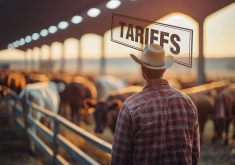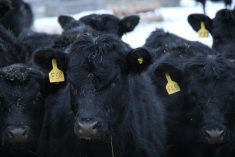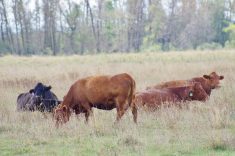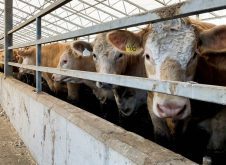Editor’s note: A recent blog from the Beef Cattle Research Council offers its rebuttal to “vilifying headlines and simple, partial arguments” that criticize the beef industry for its water use and environmental impact. The following is a condensed version of the blog, which can be found at the Beef Cattle Research Council website.
Make no mistake — it does take more water to produce a pound of uncooked, boneless beef (over 1,800 gallons/6,814 litres) than a pound of dry peas (178 gallons/674 litres), dry beans (488 gallons/1,847 litres) or dry lentils (577 gallons/2,184 litres), or any other protein crop.
Read Also

Dennis Laycraft to be inducted into the Canadian Agricultural Hall of Fame
Dennis Laycraft, Executive Vice President of the Canadian Cattle Association, is one of this year’s inductees into the Canadian Agricultural Hall of Fame. Laycraft was nominated for his many contributions to the cattle industry.
But this is only one of many pieces of information to consider.
Pastures and feed crops account for nearly all (99 per cent) of the water used in beef production. Does that mean that the land used to raise cattle should be converted to crop production?
Not necessarily. There are many reasons why not all land is suitable for cultivated agriculture and why raising beef plays an important role in sustainably feeding the population.
Thirsty crops
Water use statistics look considerably different when we balance water use with water availability.
Here’s an example: At 178 gallons per pound, dry peas have a very low water footprint. In 2011, Canada harvested 5.6 billion pounds of dry peas from 2.4 million acres of land. This works out to 414,562 gallons of water per acre of land used for dry pea production.
In contrast, Canada produced 2.46 billion pounds of beef in 2011 from 57 million acres of land to grow the pasture, forage, and other feed. This works out to 78,813 gallons per acre of land used for beef production.
What if we cultivated that grassland and tried to grow dry peas instead?
It probably wouldn’t work too well. Dry peas need more than five times as much water (414,652/78,813 = 5.3) than the grass does. Much of the land used to raise forage for beef cattle doesn’t receive adequate moisture or have the right soil conditions to support crop production, but can produce grass that can thrive in drier conditions.
Forages (pastures and harvested roughage) account for approximately 80 per cent of the feed used by beef cattle in Canada. Nearly a third of Canada’s agricultural land is pasture and not suited for crop production.
Canada’s beef herd is primarily located in the Prairies. The southern Prairies are drought prone, and the more northerly growing seasons are too short for many crops. Central and Eastern Canada generally have higher rainfall and longer growing seasons than the Prairies, but not all this farmland is suitable for crop production either. Much of this land is too boggy, stony, or bushy to allow cultivation, but it can grow grass.
Because cattle can digest fibre, they make use of the nutrients from land not suited for crop production, and convert them into high-quality protein that humans can digest.
Water isn’t lost
Like city water, the water that beef-processing facilities take out of the river at one end of the plant is treated and returns to the same river at the other end of the plant. New technologies to recycle and reuse water can reduce the amount of water needed for beef processing by 90 per cent.
The pastures and rangelands that support beef production are also an important part of the water cycle.
Because these lands are not cultivated, they are covered in living plant material all year round and are anchored by well-developed root systems that hold the soil in place. This above- and below-ground vegetation serves to trap snowfall, slow meltwater movement over the soil surface, and helps reduce run-off, overland flooding, soil erosion, and the movement of silt and nutrients into waterways. In grassland environments, this water often collects in sloughs, potholes or other low-lying areas that provide valuable nesting sites for birds. When grasslands are converted to crop production, these water bodies are often drained and cultivated.
Grasslands also have improved soil porosity due to healthy root growth and earthworm activity. This allows more water to infiltrate the soil and recharge groundwater reserves.
Greenhouse gases
Cattle produce greenhouse gases. Forages and grassland store and sequester them.
Cattle produce methane as a byproduct of digestion, particularly on pasture and other high-forage diets.
But water is not the only thing that cycles; so does carbon.
Plants take carbon dioxide out of the atmosphere, incorporate the carbon into plant structures (roots, stems, leaves, flowers, and seeds), and release oxygen back into the atmosphere. Because perennial pasture plants live for many years, they develop an extensive root system which will eventually decay and become part of the soil carbon. Carbon sequestered by these plants remains in the soil rather than being released back into the atmosphere.
Cultivating drought-prone areas instead of leaving them in permanent grassland drastically increases the risk of soil erosion, loss of topsoil, and subsequent losses of sequestered soil carbon into the atmosphere.
Cultivation also affects soil structure and water infiltration. As a general rule, when lands are left in their natural state, 10 per cent of precipitation runs off, 40 per cent evaporates and 50 per cent enters the groundwater reserves. When soils are disturbed or developed for housing or industry, water infiltration is reduced.
Grassland and forage remain the ultimate zero-tillage practice.
Ecological benefits
It’s not just dead roots that provide environmental benefits.
Because perennial forages aren’t cultivated, and often grow in dry conditions, they grow extensive root systems in their search for moisture. For example, forage legumes like alfalfa develop roots that penetrate 53 to 63 per cent deeper into the soil than chickpeas, lentils, and other pulses. All legumes can ‘fix’ nitrogen from the air and convert it into soil nitrogen that can improve soil fertility, and forage legumes like alfalfa can fix up to twice as much nitrogen per acre as annual legume crops.
Lands prone to periodic flooding or drought benefit from the permanent plant cover. Roots and vegetation keep the soil in place so that it doesn’t wash away in a flood or blow away during a drought. Extensive root systems also help improve soil structure and water-holding capacity and water infiltration, and allow groundwater reserves to recharge better than croplands.
Grasslands also provide habitat for small and large mammals, hawks, nesting birds, songbirds and pollinating insects, and preserve biodiversity.
Feed footprint
Crops (primarily feed grains) account for roughly 20 per cent of the feed consumed by cattle.
Some are deliberately seeded to produce feed grain for cattle, but not many. For example, barley that does not achieve malt grade is recycled into high-quality protein rather than being discarded. A similar scenario occurs for wheat that does not meet the criteria for human consumption.
Cattle also make use of many crop byproducts that humans can’t use. For most crops, only the seed is used for human consumption, whether it is milled for flour, sprouted for brewing, split for pea soup, pressed for oil, or cooked and eaten whole. The rest of the plant — stems, leaves, shells, screenings, hulls, shrivelled and cracked seeds, residues from brewing and bioethanol production — are useless for human food but are excellent, high-quality feed for cattle.
Many environmentally sustainable and economically healthy farm operations produce both beef cattle and crops. In the same way, a balanced, environmentally sustainable, healthy diet includes both plants and beef.















